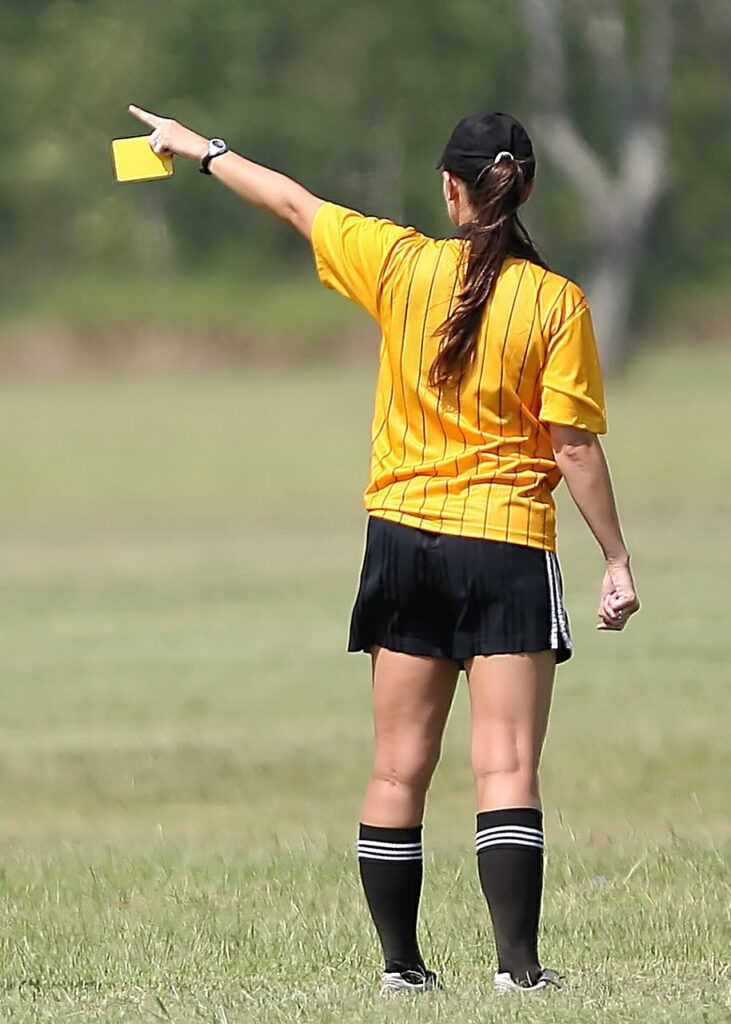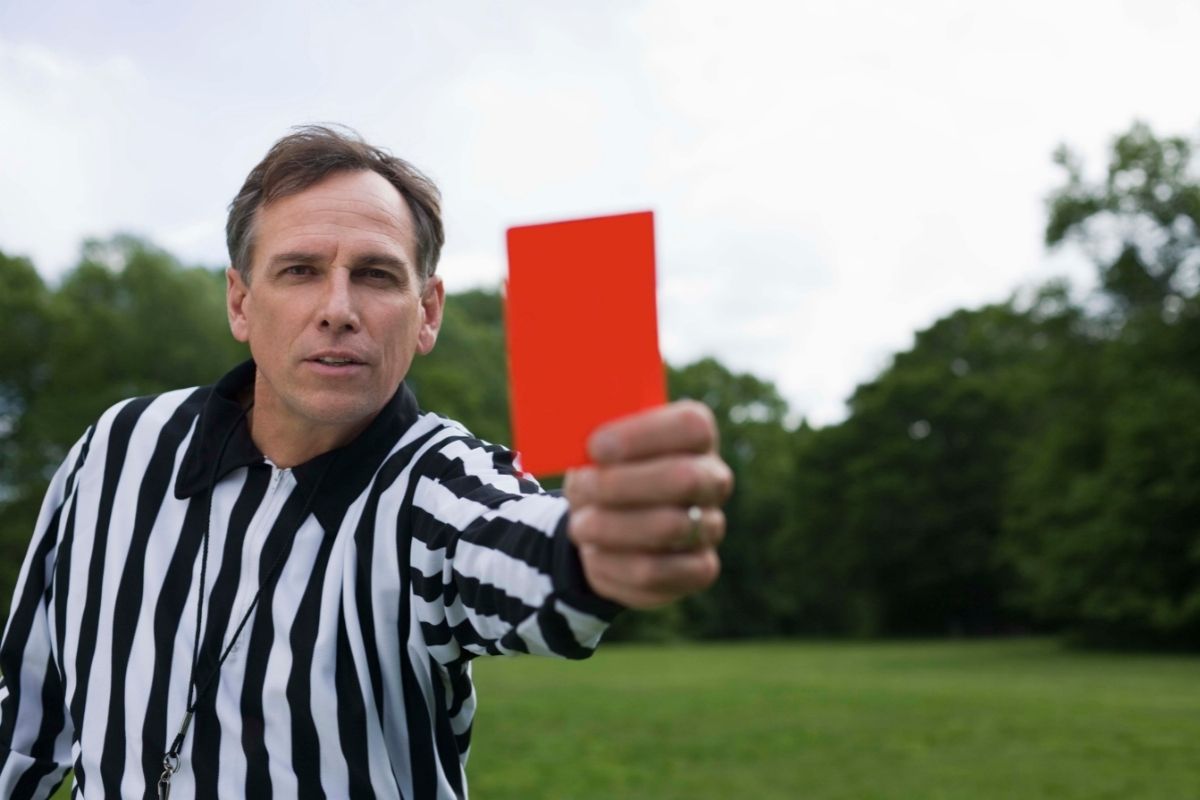When a referee pulls out a yellow card during a soccer match, it’s usually a sign that a player has committed a foul. But have you ever wondered what referees write on these cards? The answer is simple.
On the red or yellow card, the soccer referee writes the player’s name, the reason for the caution, and the time of the offense.
Yellow cards caution players for unsportsmanlike behavior, such as dangerous tackles, time-wasting, or dissent. The referee will usually hold up the card and show it to the player, then write down the details in their notebook. The player who receives a yellow card must also leave the field briefly, giving them time to reflect on their actions and hopefully avoid committing further fouls.


What is a Yellow Card?
A yellow card is a cautionary warning issued by a referee to a player who has committed a foul or misconduct during a soccer match. It is a formal way of indicating that the player’s behavior is unacceptable and that any further violations may result in more severe disciplinary action.
The referee typically shows yellow cards by holding up a yellow card and displaying it to the player who committed the offense. The referee will also record the player’s name and the time of the incident in their notebook.
Yellow cards are typically issued for minor offenses, such as unsporting behavior, dissent, delaying the restart of play, or reckless challenges. However, if a player receives two yellow cards during a match, they will be sent off the field and not allowed to continue playing.
In addition to being a warning to the player, yellow cards also serve as a way for the referee to keep track of the game and ensure that it is played fairly and safely. By issuing yellow cards, the referee can help prevent further misconduct and ensure the match is played within the rules.
What Offenses Result in a Yellow Card?
When a player commits a cautionable offense, the referee will show them a yellow card. The yellow card indicates a warning to the player that their behavior is unacceptable, and if they continue to act in the same way, they may be sent off the field with a red card.
Cautionable Offenses
The following offenses are considered cautionable offenses:
- Foul play
- Unsporting behavior
- Dissent by word or action
- Deliberately delaying the restart of play
- Attempts to deceive the referee
- Leaving the field of play without the referee’s permission
- Infringements against opponents
- Goalkeeper offenses
- Referee interference
- Equipment and uniform violations
Yellow Card for Aggressive or Unsportsmanlike Behavior
Players who act aggressively or engage in unsportsmanlike behavior, such as pushing, tripping, or using excessive force, will receive a yellow card.
Yellow Card for Attempts to Deceive the Referee
Players who simulate a foul or injury or try to trick the referee into making a wrong decision will receive a yellow card.
Yellow Card for Delaying the Game
Players who deliberately delay the restart of play, such as kicking the ball away or taking too long to take a throw-in, will receive a yellow card.
Yellow Card for Dissent
Players who show a lack of respect for the game or the referee, such as arguing with the referee’s decision or using offensive language, will receive a yellow card.
Yellow Card for Infringements Against Opponents
Players who commit fouls against their opponents, such as holding, tripping, or pushing, will receive a yellow card.
Yellow Card for Goalkeeper Offenses
Goalkeepers who commit offenses like holding the ball for more than six seconds or handling it outside their penalty area will receive a yellow card.
Yellow Card for Referee Interference
Players or team officials who interfere with the referee’s decision-making or try to influence the referee’s decisions will receive a yellow card.
Yellow Card for Two Yellow Cards
If a player obtains two yellow cards in the game, they will be automatically ejected with a red card.
Yellow Card for Leaving and Entering the Field of Play
Players who leave or enter the field without the referee’s permission will receive a yellow card.
Yellow Card for Equipment and Uniform Violations
Players who wear unauthorized equipment or uniforms or fail to comply with equipment regulations will receive a yellow card.
Overall, yellow cards are shown to players who commit cautionable offenses. Players need to understand the rules and regulations of the game to avoid receiving a yellow card and potentially being sent off the field with a red card.
What Do Referees Write on Yellow Cards?
When a referee decides to book a player with a yellow card, they must write down certain information on the card. This information includes the player’s name, jersey number, and why they were cautioned. Referees also keep a notebook to record the details of the match, including any cautions or send-offs.
The referee will typically take their yellow card from their wallet and show it to the player while writing down the necessary information. The yellow card serves as a warning to the player and helps the referee track how many cautions each player has received. Players who accumulate too many yellow cards may be suspended for a future match.
In addition to the player’s name and number, the referee may also write down the time of the caution and the reason for the booking. This helps ensure consistency in the referee’s decisions and can be used for disciplinary purposes if necessary.
Overall, the information on a yellow card is important for the referee and the player. It helps track disciplinary actions and ensures the game is played fairly and within the rules.
What Happens After a Player Receives a Yellow Card?
When a player receives a yellow card, it is a warning from the referee for a cautionable offense. The referee’s notebook records the player’s name and reason for the caution. The yellow card is also shown to the player, and the referee will indicate the player’s number to the fourth official.
Consequences of Receiving a Yellow Card
A player receiving two yellow cards in the same match results in a red card, which means the player is sent off the field. Additionally, a player accumulating five yellow cards throughout the season will receive a one-match suspension. Players who accumulate ten yellow cards throughout the season will receive a two-match suspension.
Referee Review Area
After a player receives a yellow card, the referee may review the incident in the referee review area. This area is a designated location where the referee can view replays of the incident to determine if the caution was warranted.
Red Card
If a player receives a red card, they are immediately sent off the field, and their team must play with one fewer player for the rest of the match. The referee’s notebook records the player’s name and reason for the red card.
Penalty Kick
If a player commits a foul inside their penalty area, it results in a penalty kick for the opposing team. The player who committed the foul may also receive a yellow or red card, depending on the severity of the foul.
Free Kick
If a player commits a foul outside their penalty area, it results in a free kick for the opposing team. The player who committed the foul may also receive a yellow or red card, depending on the severity of the foul.
Substitution
If a player receives a yellow card, their team may substitute them to avoid the risk of receiving a second yellow card. If a player receives a red card, their team must make a substitution to replace the sent-off player.
Misconduct Report
After the match, the referee will submit a misconduct report to the competition’s governing body. This report includes any cautions or red cards issued during the match.
Ken Aston’s Contribution
Ken Aston, a former referee, is credited with inventing the yellow and red card system. He introduced the cards during the 1966 World Cup to help referees communicate with players and avoid language barriers. The yellow card was initially used as a warning, while the red card was used for sending off players.
Conclusion
In conclusion, yellow cards are an essential tool used by referees to maintain discipline during football matches. Referees use them to warn players who have committed a foul or shown unsportsmanlike conduct. The information written on yellow cards is crucial for players, coaches, and fans to understand the reason for the caution.
Referees write various pieces of information on yellow cards, including the player’s name, the reason for the caution, and the time of the offense. This information helps players and coaches identify the player who received the caution and its reason. Referees may also add notes to the card, such as the offense’s location or the foul’s severity.
It is essential to note that the information written on yellow cards is not always the same. Different leagues and organizations may have their own specific guidelines for what referees should write on yellow cards. However, the basic information remains the same across all leagues.
Overall, yellow cards are essential for referees to maintain discipline during football matches. The information written on them is crucial for players and coaches to understand the reason for the caution. Referees must ensure they write the correct information on yellow cards to avoid confusion and maintain fairness during the game.
- Can You Play Pickleball on Grass? Tips and Tricks - June 12, 2023
- Do Pickleballs Wear Out? Everything You Need to Know - June 12, 2023
- Can You Play Pickleball on Concrete? A Guide to Playing on Hard Surfaces - June 12, 2023








